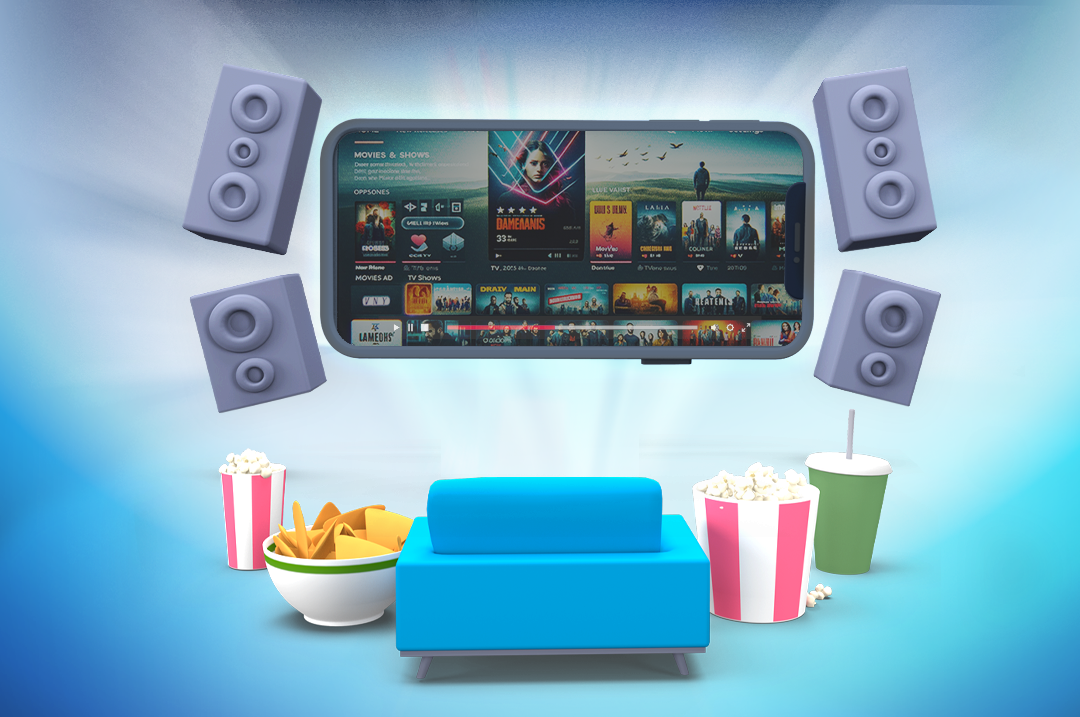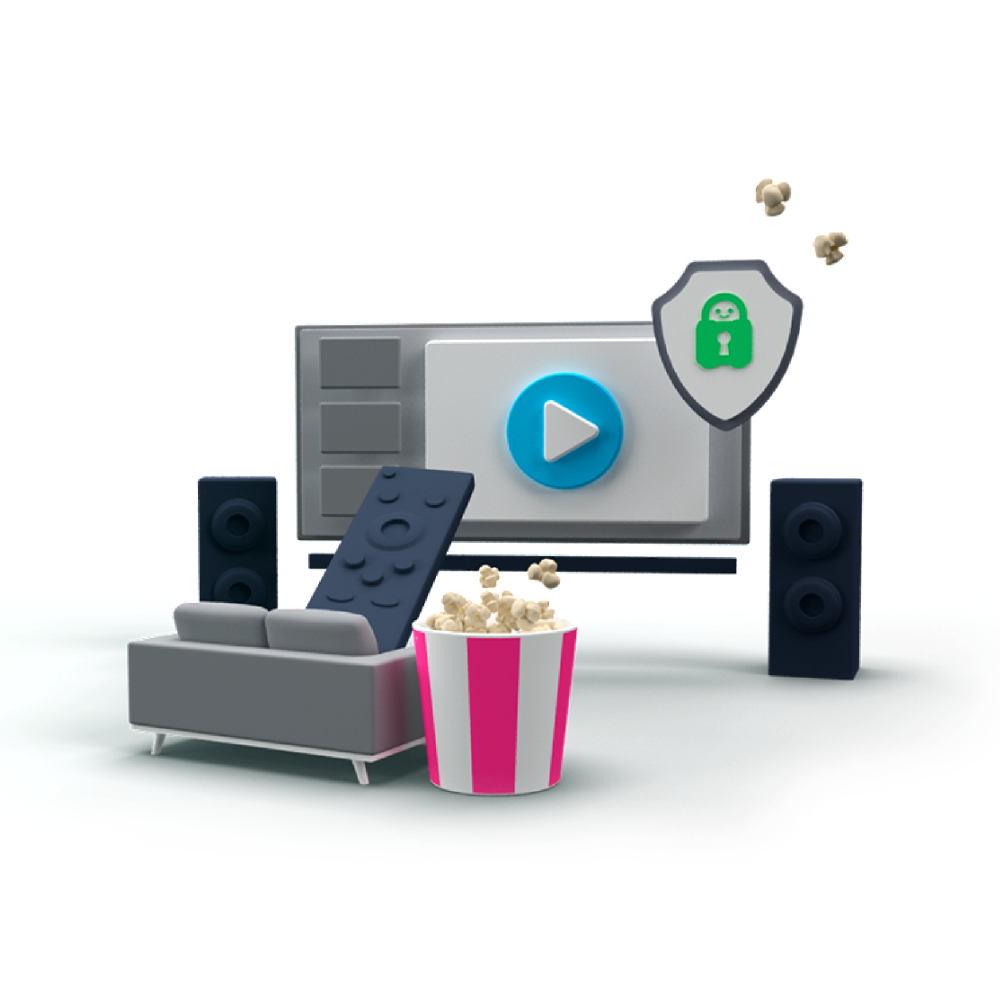
Cable is old school. IPTV? That’s cool. This internet-based alternative to traditional cable gives you more control over the channels included in your lineup, when you can watch your favorite content, and what your package costs.
The freedom that these platforms offer has led to an explosion in their popularity over the past few years. That said, there’s still a little bit of mystery around how they work and how viewers can use them.
In this guide, we’ll walk you through everything you need to know about IPTV, including setup tips and troubleshooting advice, plus how PIA VPN can help you make the most of your IPTV subscriptions.
Quick Guide: How to Watch IPTV with a VPN
Unblock live TV platforms on restricted Wi-Fi networks or watch your usual content when traveling abroad with a VPN.
- Get PIA VPN.
- Connect to a streaming-optimized server.
- Watch TV online.
What Is IPTV and How Does It Work?
Let’s start with the basics: IPTV stands for Internet Protocol Television. These services offer you a way to watch live TV and on-demand content via the internet without a traditional cable or satellite contract.
To use IPTV services, you’ll typically need to choose a provider and download a compatible app or player onto your streaming device. This is way more convenient – and usually cheaper – than having to set up an antenna or set-top box and connect it to your TV to access content.
One of the big pluses of IPTV is its flexibility. With the right service, you can access everything from live news and sports channels to entire libraries of on-demand movies, series, and even international content. On top of that, you can watch content on a range of devices. Most IPTV providers have apps for smartphones, tablets, streaming sticks, and other popular streaming devices.
Different Types of IPTV
There are a few different IPTV formats that you can choose from: live TV, time-shifted TV, video-on-demand (VOD), and near-video-on-demand. The one that best suits you will depend on when and how you prefer to watch content.
Live TV is exactly what it sounds like. It lets you watch broadcasts in real time, just like traditional television. With a live TV service, like Hulu + Live TV, YouTube TV, or Sling TV, you’ll get access to live sports, news, or entertainment channels.
On the opposite end of the spectrum are VOD services. These give you access to a library of content that you can watch whenever you want. Your platform choice will likely hinge on the type of content you prefer. For example, Netflix is great for movie buffs, while Hulu is best for original series.
Some streaming platforms offer time-shifted or catch-up TV. These services, like BBC iPlayer, allow you to replay recently broadcast shows. While this might sound similar to VOD, there’s one key difference: the content is only available for a specific time period (usually up to a week or so).
Finally, there’s near-video-on-demand. It’s used mostly for pay-per-view content, like special sports events or movie premiers. The content plays on a set schedule, but there are usually multiple start times for a particular program – kind of like an online movie theater.
Some services offer a mix of live and/or catch-up TV and on-demand content, whereas other providers specialize in one format. You’ll have to weigh your preferences about live versus on-demand content to decide which works best for you.
Pros and Cons of IPTV
Like any service, IPTV has its upsides and inconveniences. Here’s how it stacks up compared to traditional cable:
| Pros | Cons |
| Greater flexibility: Watch live or on-demand TV whenever it suits you. | Needs stable, high-speed internet: Slow or unstable connections will cause buffering. |
| No bulky hardware: Stream directly on your device without the need for satellites, antenna, or set-top boxes. | Channel availability fluctuates: Not all IPTV providers offer the same channels and their line-ups can change. |
| Watch on the go: Download your IPTV app onto your smart TV, smartphone, tablet, or laptop to watch anywhere. | Video quality varies: Depending on your provider, you may not be able to stream content in HD or UHD. |
| Better pricing: Many IPTV services are more affordable than standard cable packages. | Choosing can be challenging: The differences between services can make it tough to pick one. |
| Wide range of services available: As well as the streaming giants you’ll have heard of, there are many smaller IPTV services. | Unverified apps can be risky: Use a VPN and exercise caution when sideloading apps or using less well-known IPTV services. |
Why You Need a VPN for IPTV
Some IPTV services are only available in a single country and even if a platform is more widely available, the shows, movies, and TV channels you can access will vary from country to country. This can be annoying when you’re traveling abroad and lose access to the shows you like.

A VPN can help you access your usual subscriptions and content libraries. It masks your IP address to change your virtual location. Connect to a VPN server in your home country and it will seem to your streaming service like you never left. You can continue to watch local news, your favorite channels, and all your on-demand content while you’re away.
Watching IPTV with a VPN is also useful if you’re streaming on a restricted network where services might be blocked. This is common on office and school networks, but public Wi-Fi in places like hotels and libraries may also block streaming sites to conserve bandwidth. A VPN enables you to get around these blocks and watch your favorite content on any network.
VPN encryption keeps your connection secure, so your streaming activity stays completely private. This stops your ISP of any other third party monitoring your connection from seeing what you’re doing online, and secures all your internet traffic.
Another big perk? Avoiding content-based throttling. Some ISPs slow down streaming traffic during peak times. By hiding what you’re doing online, a VPN can help you maintain consistent speeds for reliable streaming even during busy periods.
How to Use IPTV Smarters and Other Media Players
IPTV players such as Kodi, Smarters, and MyIPTV Player let you bring different IPTV channels and streamers together in one app. They typically don’t host content, but act as a gateway to different services. Some, like Kodi, even let you add your own content, so you can access all your entertainment from one app.
Many popular IPTV players have apps that you can download from your device’s app store. If you want to use them on your Fire TV Stick, you may need to use a different method, which we’ve outlined below.
It’s best to be cautious when adding IPTV channels and add-ons to your media player to make sure you’re only accessing legitimate content. These third-party services may lack the same privacy protections as big-name platforms, so it’s best to connect to PIA VPN before using them to protect your data and avoid exposing your IP address.
Setting Up an IPTV Player: How to Use IPTV on Multiple Devices
Whether you’re streaming on your TV, smartphone, or laptop, we’ll show you how to get IPTV running smoothly across all your screens.
How to Use IPTV on Windows, Mac, and Other Computers
Many IPTV services offer native apps for Windows, macOS, and even Linux, but that isn’t always the case. For example, IPTV Smarters Pro doesn’t offer native support for macOS or some older versions of Windows, which can make setup a bit more complicated.
If your IPTV service doesn’t have an app for your computer, you may be able to access it through your browser. This is also an easy way to get consistent access to your IPTV account when visiting a country where the service may not be available. Just follow these simple steps:
- Get PIA VPN: Install PIA’s native app for Windows, macOS, or Linux and connect to a server in your home country where your IPTV service is available.
- Open your web browser: Navigate to your IPTV provider’s website and log in with your subscription details.
- Start streaming!
How to Install IPTV on a TV Box, Chromecast, and Google TV Streamer
Using a portable streaming device like Roku, Apple TV, or Google TV Streamer is a great way to use IPTV on your big screen without needing a smart TV. You can download many IPTV apps from your device’s app store, which is the easiest way to install a service. The catch is that not all devices support all IPTV apps – this is particularly true of Roku.
The easiest way to use IPTV on Chromecast, Roku, and other devices in this situation is to access your IPTV service on your smartphone and use screen mirroring or casting to watch on your TV.
How to Use IPTV on a Fire TV Stick
One of the best things about the Amazon Fire TV Stick is its portability. It’s compact enough to take with you wherever you go, making it a great option for watching IPTV on the TV in your hotel or Airbnb while you’re traveling abroad.
Many IPTV apps are available directly through the Amazon Appstore. Type the platform name into the search bar on the Fire TV Stick home screen to find and download the app for your streaming service.
Several popular IPTV media players like Kodi and Smarters aren’t available in the Amazon Appstore. If the IPTV service you want isn’t available to download directly, there’s a workaround you can use to sideload these apps onto your Fire TV Stick.
As an example, here’s how to use IPTV Smarters Pro on Fire Stick:
- Download PIA VPN: It’s especially important to use a VPN when sideloading apps, as third party app stores may not be as secure as the Appstore.
- Connect to a VPN server: Choose a VPN server location where the app is available.
- Install the Downloader app: Type “Downloader” into the search bar on the Fire Stick home screen. Select Downloader from the list of options and click on the download icon to install the app.
- Give permission for the app to be used: From the Fire Stick home screen, navigate to Settings > My Fire TV > Developer Options and select Install unknown apps or Enable apps from unknown sources. Select the Downloader app to activate it.
- Download your IPTV app: Open the Downloader app and search for the URL of the IPTV Smarters Pro app.
- Download and install the app: Once the installation is complete, click Done to return to the Downloader app.
- Open IPTV Smarters Pro: You can now access IPTV Smarters Pro on your Fire Stick and bring all your media files together in one place.
How to Use IPTV on Game Consoles
If you use your game console as your main entertainment hub, then you’ll likely want to add your IPTV platform to it as well. Whether you’re using an Xbox or PlayStation, many IPTV apps are available to download directly from your console’s app store, letting you access live and on-demand content without switching devices.
App availability can vary slightly between platforms. If your IPTV service isn’t available, some providers also support casting or screen mirroring from your phone or tablet as a backup.
How to Fix Common IPTV Issues
Even if you’ve followed all of the setup instructions to the letter, you can still run into the occasional IPTV hiccup. Here’s how to easily handle some of the most common IPTV problems.
Buffering or Freezing
Buffering and freezing are often caused by a slow or unstable internet connection. Try restarting your router, closing all other apps or windows, reducing the number of devices using your network, or switching to a wired connection. You can also lower the streaming quality in your IPTV app settings to ease the load.
Channels Not Loading
If certain channels aren’t showing up, it could be an issue with your IPTV provider’s server or an outdated playlist. Try refreshing or reloading your playlist URL and check your provider’s status page or support channels for known outages.
App Keeps Crashing
Apps sometimes misbehave after updates or if the device is low on memory. Clear the app’s cache, restart your device, or uninstall and reinstall the app. It’s also a good idea to update the app so that you’re using the latest version.
Tips for Optimizing Your IPTV Experience
A few simple tweaks can go a long way in improving the quality and consistency of your IPTV streams. Here are a couple of things you can do to get the best IPTV experience possible:
- Use a VPN: A VPN protects data such as your IP address from being exposed. It also lets you access your IPTV service when you’re traveling abroad and can help prevent interruptions caused by content-based throttling.
- Upgrade your internet connection: Make sure your connection speed is suitable for streaming – you’ll usually need a minimum of 20 Mbps for HD streaming.
- Keep your app updated: App updates fix bugs, improve performance, and add features, so downloading the latest version can help you avoid glitches.
- Clear your cache regularly: Freeing up device memory can help prevent lag, crashes, and slow performance.
- Don’t overload your network: Only stream on as many devices as your internet connection can accommodate to avoid buffering.
- Use quality hardware: Older devices can struggle with IPTV apps. If possible, use a modern streaming stick, smart TV, or TV box for the best experience.
Why PIA Is the Best VPN for IPTV
Not all VPNs are created equal, especially when it comes to streaming. Here’s why PIA is the best IPTV VPN:

✅Servers in 91 countries: Whether you’re watching at home or traveling abroad, it’s easy to find a server wherever you need one.
✅10-Gbps server network: Our servers can easily handle high-bandwidth activities like streaming, so you can watch in HD without putting up with buffering or long load times, even during peak hours.
✅Streaming-compatible: PIA offers streaming-optimized servers in key countries around the world which work smoothly with popular IPTV services and streaming platforms.
✅Unlimited bandwidth: Watch as much content as you like without worrying that you’ll be cut off from your stream because you’ve hit your data limit.
✅Robust encryption: Bypass streaming blocks on restricted networks and stream safely at home, work, school, or even while connected to public Wi-Fi.
✅Native VPN apps: PIA has apps for Windows, macOS, Android, iOS, Amazon Fire TV Stick, Apple TV, and a variety of other popular streaming devices. You can also configure PIA on your router to cover all of the devices in your home with one connection.
✅24/7 support: Our friendly customer support team is on hand to help any time of the day or night if you have any questions about our VPN service.
On top of all that, you get a 30-day money-back guarantee, so you can try PIA VPN completely risk-free and make sure it meets your needs.
FAQ
To use IPTV, you’ll first need to pick a service. Once you’ve chosen one that suits your viewing preferences, sign up and download the app onto your preferred streaming device. You can then log in and select something to watch. IPTV channels and services are often restricted to certain countries. Download a VPN to continue watching your usual content when abroad.
IPTV services let you stream live TV and on-demand shows on your smart TV, computer, tablet, or smartphone. You just need to download the compatible app onto your device and sign up to access the content library. If you’re looking for a legitimate IPTV service, read our guides to the best live TV streaming services and the best free movie streaming sites.
Getting started with IPTV is simple: choose a provider, subscribe, install their app or player on your device, and enter your login information. From there, you’ll be able to access the channel and content lineup included in your package. Alternatively, you can use an IPTV media player such as Kodi to access all your IPTV channels, subscriptions, and media files from one place.
You’ll need a stable internet connection and a compatible device (like a smart TV, phone, or streaming box) to watch IPTV. Most IPTV streaming services also require a subscription, though there are free options like Pluto TV or Tubi. It’s advisable to have an internet connection speed of at least 20 Mbps for HD streaming.
Most IPTV services have apps for Android and iOS, which let you watch on your phone. This makes it easy to stream live TV, including sports matches, news, and entertainment, as well as on-demand shows when you’re on the go. If you’re streaming on public Wi-Fi, remember to connect to a VPN before streaming to secure your connection and protect your private data.
There’s no one-size-fits-all answer when it comes to picking an IPTV service as it depends on what you want to watch, your budget, and where you live. Look for reputable providers with good reviews, solid support, and user-friendly apps. Hulu + Live TV, DirecTV, and YouTube TV are popular live TV streaming services in the US.
Yes, you can use a VPN with IPTV. A VPN lets you access your subscription when you’re traveling abroad, bypass streaming restrictions on networks where streaming is blocked (like work or school), and avoid content-based ISP throttling. It also secures your connection and stops your ISP and other third parties from monitoring your activity online.
If your IPTV service isn’t working with your VPN, it could be due to a blocked IP address or outdated app settings. Try switching to a different VPN server or restarting your device. If that doesn’t work, switch to PIA VPN. It has streaming-optimized servers that work seamlessly with IPTV platforms.
IPTV apps don’t typically have built-in VPNs. It’s best to download a VPN separately on your streaming device, as this covers all IPTV apps. PIA VPN is the best IPTV VPN as it has ultra-fast speeds for flawless streaming and streaming-optimized servers that work with popular IPTV services like Hulu and Fubo.
Your VPN server location will need to match the country or region where your IPTV service is available. For example, if you’re traveling from the US to the UK and find yourself locked out of your Tubi account, you can connect to a server back in the US to keep watching.
You’ll want a fast VPN protocol for streaming that also gives you a good level of security. PIA’s VPN protocols balance speed and security to meet your needs. If you need help choosing the right VPN protocol, our customer support team is always happy to help.
Can I use a VPN to watch a streaming service in another country?
Some VPN users may use a server in another country, where a certain streaming service is available, to connect to that service. While we cannot see what you are doing online due to our no-logs policy, this goes against our terms of service and is not acceptable.
PIA VPN puts your privacy first and we don’t track our users’ activity. That said, you should always comply with relevant laws, including copyright.
If you want to have contact with us ~ [email protected]






